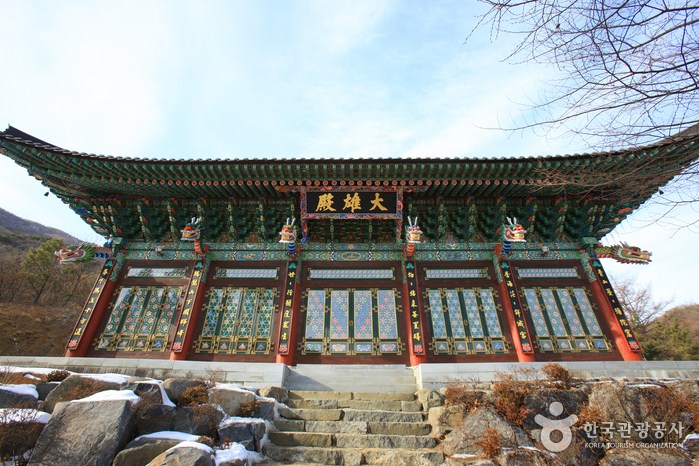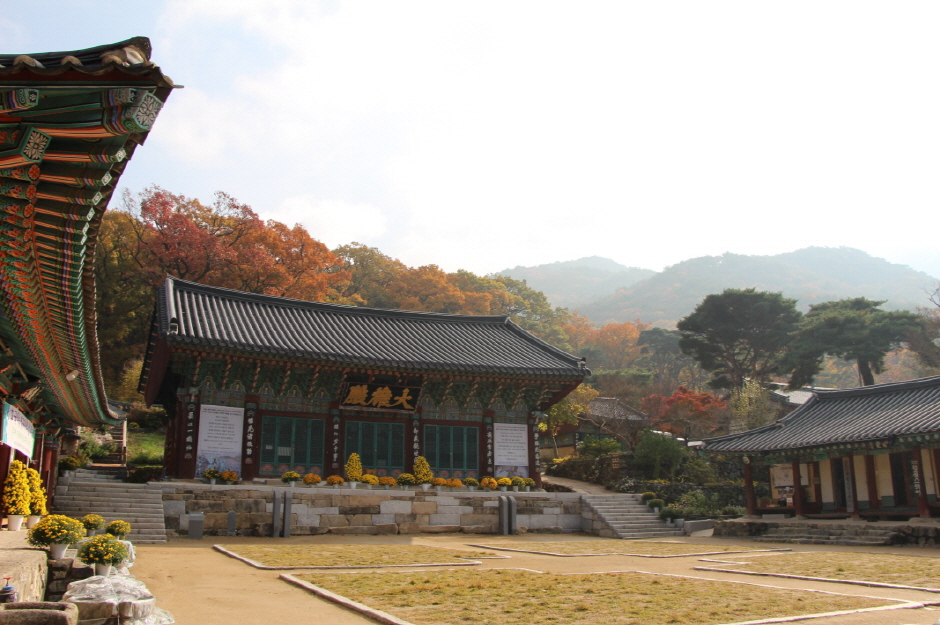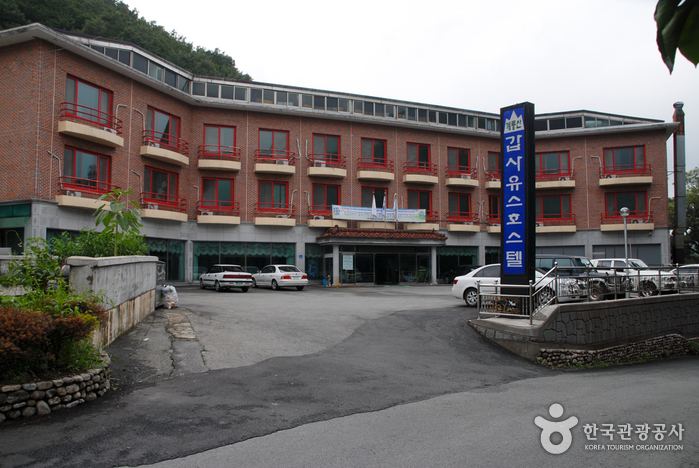Kong Daebak (콩대박)
13.8Km 2024-02-20
9 Daebak-gil, Geumnam-myeon, Sejong-si
Kong Daebak is a restaurant specializing in soybean-based dishes. There are two menu options: kongseobang bapsang and konggaksi bapsang. Kongseobang bapsang includes dishes like doenjang jjigae (soybean paste jjigae), salad, kong jeon (soybean pancake), suyuk (boiled pork slices), mushroom dishes, jangajji (pickled vegetable), and dessert. Adding dishes like kkaennip jeon (pan-fried battered perilla leaves) and dubu jeongol (bean curd hot pot) turns it into konggaksi bapsang. Since the food is prepared on the same day, advance reservations are essential.
Gyeryong Musangsa Temple (무상사(계룡))
13.9Km 2023-04-13
129, Hyangjeoksan-gil, Gyeryong-si, Chungcheongnam-do
+82-42-841-6084
Musangsa Temple is an international Zen Temple exclusively for foreigners. The temple aims at promoting Korean Zen Buddhism among foreign monks and nuns while encouraging non-Buddhist priests and religious leaders to experience Zen. Twice a year (once in the summer and once in the winter) a 3-month program is held for foreign monks and nuns to come and practice Ganhwaseon, a type of Zen Buddhism. Travelers and other foreigners are also welcome to participate in shortened versions of the program, which are typically one week in length. During meditation/program periods, public visits are limited. The temple’s yearly schedule is divided into three sections with the last section providing various events and programs including weekend events and workshops. The temple also offers temple stay and other programs run in both Korean and English.
Gapsa Temple (갑사)
14.3Km 2021-12-17
567-3, Gapsa-ro, Gongju-si, Chungcheongnam-do
+82-41-857-8981
Gapsa Temple is located in the forested foothills of Gyeryongsan Mountain, 19 kilometers from Gongju and a three-hour walk from Donghaksa Temple. The temple is most beautiful during fall when surrounded by crimson foliage. Gapsa Temple was established by monk Adohwasang in 420, during the early Baekje Period. The temple's beauty allowed it to escape destruction many times, but it was ultimately burned down during the Imjin War (1592-1598). The current structures were built in 1604. Nearby attractions include Yongmunpokpo Falls, Sujeongbong Peak, and Cheonjinbotab Pagoda.
Yahojeong (야호정)
14.4Km 2024-02-15
1869 Daecheonghosu-ro, Daedeok-gu, Daejeon
Yahojeong is a freshwater fish cuisine restaurant located near Daecheongho Lake. It offers jangeo gui (grilled eel) prepared with a special sauce and a refreshing maeuntang (spicy fish stew) made with mandarin fish, catfish, and shrimp. Situated in front of Daecheongho Lake, it allows diners to enjoy their meal accompanied by a beautiful lakeside view, making it a popular dining spot among locals.
Gujeolsa Temple (구절사)
14.6Km 2024-02-26
226, Sangjung-gil, Gunseo-myeon, Okcheon-gun, Chungcheongbuk-do
Gujeolsa Temple is a Buddhist temple located deep within the Sikjangsan Mountain in Okcheon. It was founded in 1393 and was rebuilt in 1933 to its present appearance. The road from the radio tower fork to Gujeolsa Temple in Sikjangsan Mountain’s hiking trails is lush with acacia trees, which are in full bloom in May. Another sight that should not be missed is the fog shrouding the foot of the mountain in spring and fall.
Gapsagyegok Valley (갑사계곡)
14.8Km 2024-02-21
519 Gapsa-ro, Gyeryong-myeon, Gongju-si, Chungcheongnam-do
Gapsagyegok Valley is a valley located on the northwest slope of Gyeryongsan Mountain in Gongju-si. With moderate temperatures even in summer, it is suitable as a recreational area, while the autumn foliage adds to its beauty. At the entrance lies Gapsa Temple, a Buddhist temple with various cultural assets, offering insights into Korean Buddhist culture. Within the valley, visitors can enjoy forest walks and view attractions such as the Yongmunpokpo Falls.
Kapsa Youth Hostel (계룡산 갑사 유스호스텔)
15.2Km 2020-04-23
458-4, Gapsa-ro, Gongju-si, Chungcheongnam-do
+82-41-856-4666
The Kapsa Youth Hostel is an educational trip, company training, family, and personal hostel with beautiful landscape and fresh air. There are mountains, creeks, lakes and more nearby for visitors to enjoy while relaxing at the hostel.
E-An Land (이안숲속)
15.2Km 2020-04-24
25, Sumogwon-gil, Gongju-si, Chungcheongnam-do
+82-41-855-2008
E-An Land Forest was established in 1999 when 1,836 arbor species and 1,418 herb species were planted on a land area of 1,118 hectares. The forest features a tropical garden and various other exhibition gardens, as well as thematic spaces like the Haneul Maru. The forest was finally completed in 2006. Inside the arboretum, there are various things to see such as the herb village, parakeet exhibitions, a pine tree garden, and man-made cave. There is also a mini golf course and an outdoor swimming pool. Visitors can also use the onsite pensions and the auto camping site for accommodation, making the E-An Land Forest a great place for family and group visitors.
Geumgang Pedestrian Bridge (금강보행교)
15.3Km 2023-01-04
Sejong-ri, Sejong-si
+82-44-120
Geumgang Pedestrian Bridge, a new landmark of Sejong-si, opened in March 2022. First two-story bridge in Korea, the large scale bridge with circular design provide various areas for activities. The upper part of the bridge is for pedestrian with rest area and convenience facilities, where as the lower part is a bicycle only road for those wanting exercise and smooth riding.
Daecheongho Lake (대청호)
15.3Km 2022-12-26
Dong-gu, Daejeon / Munui-myeon, Chungcheongbuk-do
+82-42-251-4748
Daecheongho Lake is a man-made lake, stretching from Daejeon to Cheongju-si, Okcheon-gun, and Boeun-gun. Construction began in 1975 and finished in 1980, and the lake supplies water for various use to people in Daejeon and Cheongju.
The reservoir water spans an area of over 72.8 ㎢ with a perimeter of 80 kilometers, and the water kept in storage has a volume of 1.5 billion tons, making the reservoir the third largest lake in Korea. The area is famous for its beautiful driving course along a tree-lined road through the nearby mountain which has an altitude of 200 to 300 meters. Also, resident birds and migratory birds, such as white heron, can be seen during summer in the upper region of the lake.




 English
English
 한국어
한국어 日本語
日本語 中文(简体)
中文(简体) Deutsch
Deutsch Français
Français Español
Español Русский
Русский